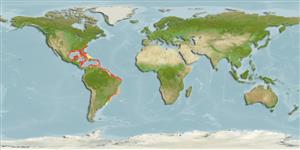Common names from other countries
Classification / Names / Names
Namen | Synonyme | Catalog of Fishes (gen., sp.) | ITIS | CoL | WoRMS
Environment: milieu / climate zone / depth range / distribution range
Ökologie
Benthopelagisch; tiefenbereich 2 - 550 m (Ref. 101460), usually 5 - 55 m (Ref. 104089). Tropical; 36°N - 36°S, 98°W - 34°W
Western Atlantic Ocean. North Carolina to Florida and Gulf of Mexico, and the West Indies to Uruguay. Subtropical to tropical.
Length at first maturity / Size / Gewicht / Alter
Maturity: Lm ? range ? - ? cm Max length : 4.3 cm CW Männchen/unbestimmt; (Ref. 93549)
Carapace width range: 0.55 to 4.29 cm (Ref. 93549). Minimum depth range from Ref. 104089. Usually in deep waters (Ref. 101460). Benthopelagic (Ref. 97531). Lives in soft bottoms (Ref. 104231), in sand and mud bottoms (Ref. 104481). Also found among broken shells and corals (Ref. 104481). In general, portunid crabs are reported to be mainly carnivorous (Ref. 72665). Feeds on polychaetes (Ref. 104232).
Life cycle and mating behavior
Geschlechtsreife | Fortpflanzung | Ablaichen | Eier | Fecundity | Larven
Members of the order Decapoda are mostly gonochoric. Mating behavior: Precopulatory courtship ritual is common (through olfactory and tactile cues); usually indirect sperm transfer.
Bisby, F.A., M.A. Ruggiero, K.L. Wilson, M. Cachuela-Palacio, S.W. Kimani, Y.R. Roskov, A. Soulier-Perkins and J. van Hertum. 2005. (Ref. 19)
IUCN Rote Liste Status (Ref. 130435)
CITES Status (Ref. 108899)
Not Evaluated
Not Evaluated
Nutzung durch Menschen
| FishSource |
Tools
Mehr Information
Alter/Größe
Wachstum
Länge-Gewicht
Länge-Länge
Morphologie
Larven
Dichte
Internet Quellen
Estimates based on models
Preferred temperature
(Ref.
115969): 22.9 - 28, mean 26.3 (based on 612 cells).
